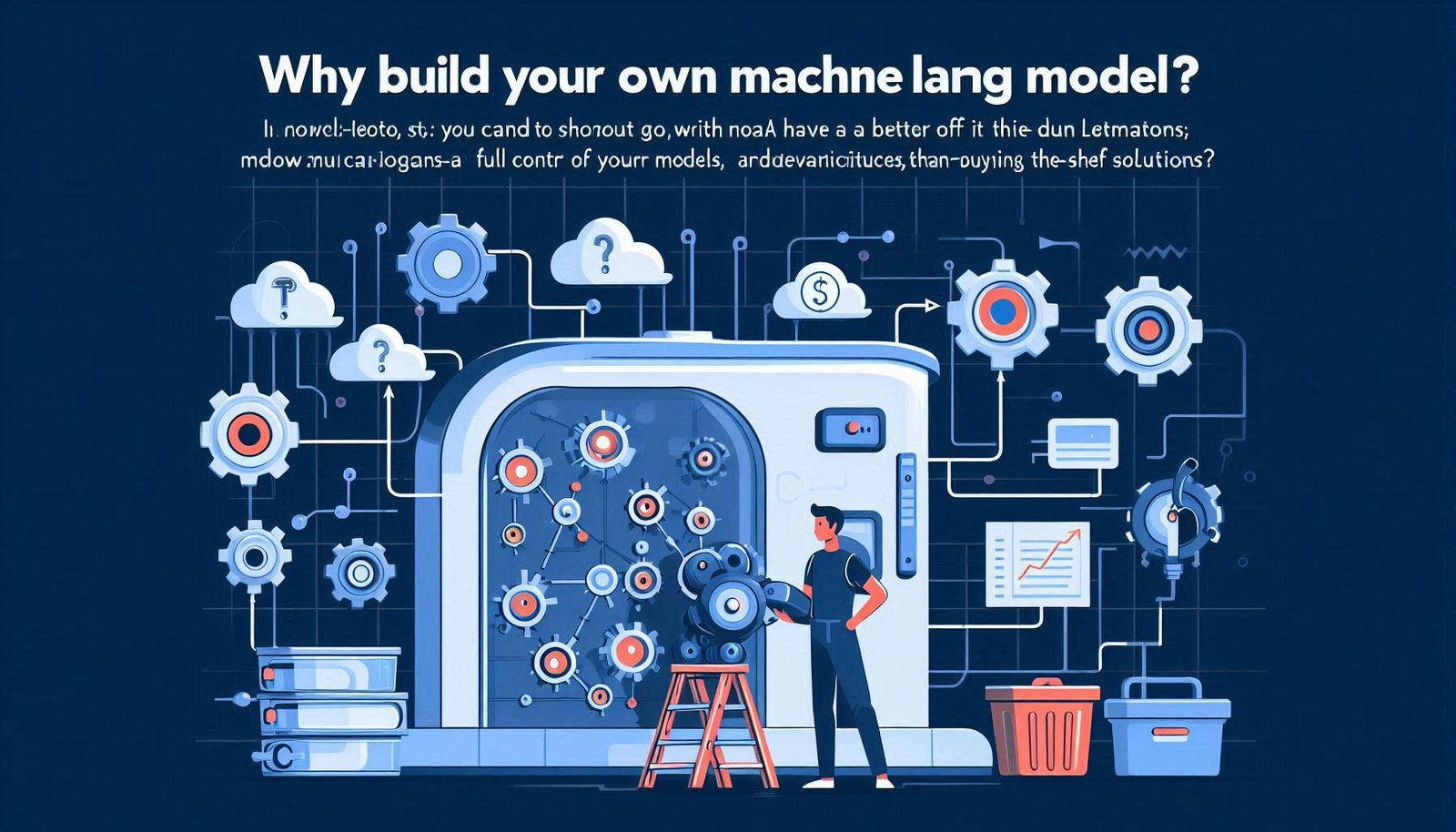Machine Learning (ML) has been powerful asset to businesses and individuals who want to draw insights from a large data set, automate a task, predict the future etc. This article will help you understand the entire process of building your own machine learning model, and walk you through the entire thing step by step if you are interested in doing so. If you are also a beginner or know basic information about machine learning, this article will help you Creating Your Own Machine Learning Model without writing any code.

What is Machine Learning?
It is a branch of artificial intelligence (AI) that allows computers to learn from data and make predictions or decisions without being explicitly programmed. It consists of using algorithms to identify patterns in data and use that information to solve problems.
So a machine learning model simply learns from previous data, evolves over time, and predicts based on new, unseen data. With common applications in image recognition, recommendation systems, speech recognition, and predictive analytics.
Why Build Your Own Machine Learning Model?
Instead, building your own machine learning model has its own merits:
In shorts, with moa you can have a:
You gain to have a better training on the data (More about Skill Development)
- AFFORDABLE: A custom-build solution can be cheaper than buying off-the-shelf solutions.
- Control and Flexibility: Full control of your model’s features, architecture, and deployment.
 Key Steps to Build a Machine Learning Model
Key Steps to Build a Machine Learning Model
Here are the critical steps involved in creating a machine learning model from scratch:
Step 1: Define the Problem
Need to understand the problem you are trying to solve before you start building a ML model. It is a key step in your project definition, as it allows you to determine the scope of your project, select the right type of model to work with, and ensure you know what data you will need.
Key Questions to Ask:
- What does this model actually wants?
- Is this a classification or regression or clustering?
- What does it mean for the model to succeed?
Step 2: Collect and Prepare Data
Since the performance is heavily dependent on data, proper data collection is important. The data you gather needs to be specific to the problem at hand.

Data Collection:
- Gather data from trusted sources, like databases, surveys, or APIs.
- Make sure that the data is diverse and representative of the problem you are trying to solve.
Data Preparation:
- Data Cleaning: Handle missing values, remove outliers, and correct any errors.
- Data Transformation : Convert categorical data to numerical values and scale the data.
-
But what to do when the magic button fails? Feature Engenharia: Create new features or modify the existing ones to improve the model performance.
Step 3: Choose a Machine Learning Algorithm
But what to do when the magic button fails? Feature Engenharia: Create new features or modify the existing ones to improve the model performance.
After preparing your data, you will need to select a machine learning algorithm to use. The classification of algorithm you use will be dictated by the issue you are attempting to address. There are several popular types of algorithms, such as:
- Supervised Learning — Model learns on labelled data (classification, regression)
- Unsupervised Learning: The model finds patterns in non-labeled data (e.g.
- Reinforcement Learning: The model learns by interacting with an environment and receiving feedback.
Here are some popular algorithms:
- Linear Regression: For regression problems.
- Logistic Regression: For binary classification.
- Tree-based models: Classification (Decision Trees) and Regression (e.g. Random Forest, XGBoost)
- K Nearest Neighbors (KNN): For classification and regression.
- SVM: Support Vector Machines for classification
- K-Means Clustering: For unsupervised learning.
Step 4: Train the Model
Training the Model: This step consists of using the selected algorithm to learn from the prepared data. In this step, the algorithm tweaks its parameters to reduce error and make better predictions.
- We will split the data into a training set (typically 80%) and a test set (typically 20%)
- Run the training data through the algorithm — it will change according to patternsin the data.
Step 5: Evaluate the Model
Once the training is complete, it is time to check how well your model is performing. You can do this by comparing its predictions with actual outcomes using evaluation metrics.
Common Evaluation Metrics:
- Accuracy: Percentage of correct predictions.
- Precision and Recall: For classification problems.
- Mean Squared Error(MSE): Commonly used for regression tasks
- Confusion Matrix: For classification problems to see how well, the model is able to distinguish between classes.
Step 6: Fine-Tune the Model
If you find the model’s performance is not sufficient, you can fine-tune it. Now as a result there are multiple ways to boost your model performance:
- Hyperparameter Tuning: Adjust parameters like learning rate or number of trees in decision trees.
- Feature Selection: Remove irrelevant features that might reduce accuracy.
- Cross-Validation: Split data into multiple subsets to ensure the model is generalizable.
Step 7: Deploy the Model
If you have a trained and evaluated model, the last step is deployment. Exposed means bringing the model into an application, so it can be used to predict on new, realtime data.
Deployment might involve:
- Making an API that lets users access the model
- Using a cloud platform like AWS, Google Cloud, or Azure to host the model.
- Ensuring the model is still good at predicting over time.
Common Machine Learning Algorithms
| Algorithm | Type | Use Case |
|---|---|---|
| Linear Regression | Supervised | Predicting continuous values (e.g., sales) |
| Logistic Regression | Supervised | Binary classification (e.g., spam detection) |
| Decision Trees | Supervised | Classification and regression tasks |
| K-Means Clustering | Unsupervised | Grouping similar data (e.g., customer segmentation) |
| Support Vector Machines | Supervised | Classification (e.g., image recognition) |
| K-Nearest Neighbors (KNN) | Supervised | Classification and regression |
Tools and Platforms for Building ML Models
Building a machine learning model doesn’t always require writing complex code. Many tools and platforms offer simple interfaces to create models. Here are some popular options:
- Google Colab: Free for training machine learning models with access to a Python environment with all GPUs.
- Azure ML: Microsoft’s cloud-based platform focused on drag-and-drop tools to build models without writing a line of code
- For IBM Watson Studio: An integrated environment for developing, training, and deploying machine learning models.
- Focused on machine learning and big data, RapidMiner is a data science platform that includes no-code tools for building machine-learning models.
FAQs
1. Do I need coding skills to build a machine learning model?
Many platforms provide capabilities of building ML model without writing code. Nonetheless, by grasping key concepts, you can use these tools more effectively.
2. How long does it take to build a machine learning model?
The hour it takes all depends on how complex the particular problem is, how big your data is, and what model you are constructing. It can be a few hours or a few weeks.
3. What if my model is underperforming?
With this process you can tune the hyperparameters, larger data, or other algorithms to produce a better model. You can also use cross-validation to guide us improve the model’s performance.
4. Can I use my machine learning model for real-time predictions?
Yes, your model can detect in real-time (depends on the application) after deployment.
Conclusion
This project is an exciting and rewarding one that will help you understand steps involved in creating your own machine learning model. With this guide in hand, get ready to start building the machine learning project of your dreams! And once you have the tools needed, as well as a simple idea of what the steps would look like, you will be able to make powerful models that can help you to solve real problems, automate tasks, and make decisions based on data instead of pure opinion.
Machine learning is an iterative process so be happy to try different things and enhance your model till eternity. It is important to mention that each of these actions is contributing to your personal or professional work projects and the skills behind them so you can explore more about what data science is.